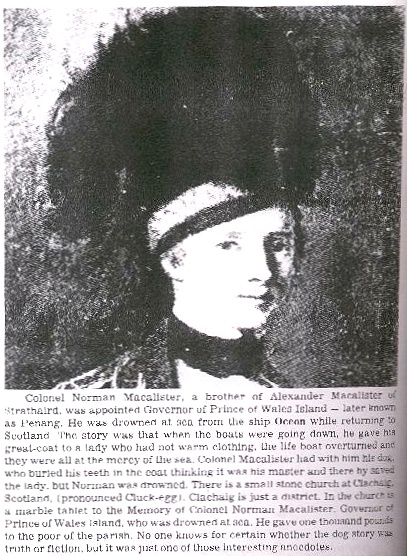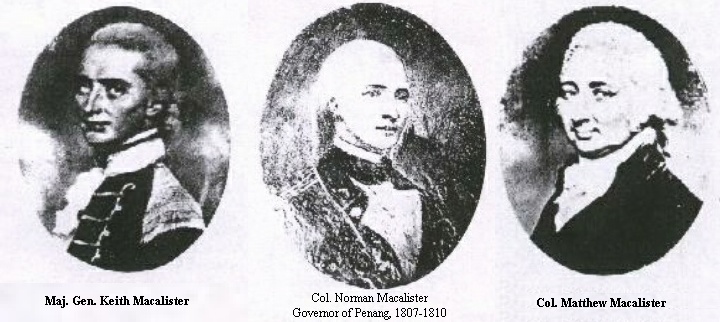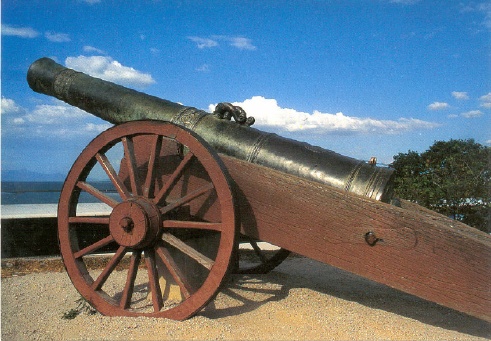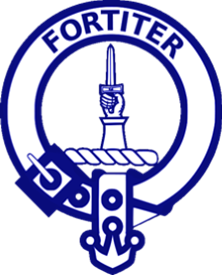Macalisters in Britain's Colonial Past
By Robert M. McAllister
 In November 2001, I received an e-mail from Danny Saw, a resident of Penang, which is an island off the west coast of the state of West Malaysia, north of Singapore. Danny, whose full name is Winson Saw Chin Beng, asked if I had a picture of Col. Norman Macalister, who had been Governor of Prince of Wales Island (located in the Straits of Malacca) from 1807 to 1810. Penang was formerly called Prince of Wales Island, during the time when the Malay States were a British colony. I knew that the only one who would have such a picture would be Angus Macalister, fifth Laird of Glenbarr in Scotland, since Colonel Norman Macalister was a brother of Matthew Macalister, first Laird of Glenbarr. I wrote Angus, who kindly sent copies of his pictures of Colonel Macalister and his brothers to Danny and to me. Danny also sent me a lot of printed information about the Penang of the past, and today. This query opened up an entirely new aspect of the story of the Macalisters in Scotland, and in the colonial world of the late eighteenth and early nineteenth centuries in general.
In November 2001, I received an e-mail from Danny Saw, a resident of Penang, which is an island off the west coast of the state of West Malaysia, north of Singapore. Danny, whose full name is Winson Saw Chin Beng, asked if I had a picture of Col. Norman Macalister, who had been Governor of Prince of Wales Island (located in the Straits of Malacca) from 1807 to 1810. Penang was formerly called Prince of Wales Island, during the time when the Malay States were a British colony. I knew that the only one who would have such a picture would be Angus Macalister, fifth Laird of Glenbarr in Scotland, since Colonel Norman Macalister was a brother of Matthew Macalister, first Laird of Glenbarr. I wrote Angus, who kindly sent copies of his pictures of Colonel Macalister and his brothers to Danny and to me. Danny also sent me a lot of printed information about the Penang of the past, and today. This query opened up an entirely new aspect of the story of the Macalisters in Scotland, and in the colonial world of the late eighteenth and early nineteenth centuries in general.
In the years immediately after the loss of America in 1783 by Great Britain during the Revolutionary War, her colonization of Asia was accelerated. Australia was considered so remote and unprofitable that it was initially occupied by prisoners from jails all over Great Britain. India and the Malay States were the colonies where great fortunes and reputations could be made in a time when there was no income tax. Lord Cornwallis, who surrendered to General George Washington at Yorktown, restored his military reputation in India. Emigration from Great Britain to the Asian colonies was accelerated during the Napoleonic Wars (1795 - 1815). The colonies of India, the Malay States, Burma, and Ceylon were rich parts of the British possessions in Asia. The jewel of the British crown was India, which was ruled by a Viceroy after the Mutiny of 1857. Prior to that time, India was run by the East India Company, which had its own army, navy and civil service. European colonization in Asia began with merchants who set up trading centers in the coastal ports. They were shortly followed by the military, who protected the merchants. Then came the church which worked to convert the millions of Hindus, Moslems and others to Christianity. Last but not least were the bureaucrats who supervised the collection of taxes, built the railroads and highways, and established the banks and an educational system. Among the hundreds of thousands of men and women from Great Britain who flocked to the Asian colonies were English, Scotch, Welsh and Irish merchants, soldiers and sailors, churchmen and bureaucrats. And among the Scots were many Macalisters, including four of the sons of Ronald (13 November 1715 to1762) and Anne Macdonald Macalister, of Torrisdale Glen in the Island of Skye.
Although all of the Macalisters in this article are listed in the Clan McAlister of America computer data base in the J10 family line, their lineage has also been recorded in more detail in the MAC1 data base. I hope to be able to link more CMA family lines to their ancestors in MAC1. They are, after all, our own ancestors in name and blood.
 In order to establish a preliminary genealogical record of Scottish Macalisters, I have constructed the MAC1 data base of our ancestors. The entries are documented in the studies and genealogies which have been done by researchers like Capt. Ian MacDonald of Clachan, and many
others. MAC1 contains all of the Scottish Macalisters (all spellings), known to me, back to Alasdair Mor, the progenitor of our extended family. It lists the genealogy of three of the four major Macalister families: Loup, Tarbert and Glenbarr. At some future time, I hope to record the lineage of the fourth family, the Alexanders of Menstrie. I expect that as the new records assembled by the Scottish Records Project are researched, many more of the entries in MAC1 will
be documented, new names added, and more relationships determined.
In order to establish a preliminary genealogical record of Scottish Macalisters, I have constructed the MAC1 data base of our ancestors. The entries are documented in the studies and genealogies which have been done by researchers like Capt. Ian MacDonald of Clachan, and many
others. MAC1 contains all of the Scottish Macalisters (all spellings), known to me, back to Alasdair Mor, the progenitor of our extended family. It lists the genealogy of three of the four major Macalister families: Loup, Tarbert and Glenbarr. At some future time, I hope to record the lineage of the fourth family, the Alexanders of Menstrie. I expect that as the new records assembled by the Scottish Records Project are researched, many more of the entries in MAC1 will
be documented, new names added, and more relationships determined.
The designation for Ronald and Anne Macdonald Macalister of Torrisdale Glen is MAC1- 1-1-1-1-1-1-1-3-1-1-3, meaning that he was a twelfth generation descendant of Alasdair Mor. Anne Macdonald was a sister of Flora Macdonald, who protected and guided Prince Charles Edward Stewart during his escape from Scotland after the Battle of Culloden in 1745. Ronald and Anne who are also designated J10-2, had nine children recorded in the MAC1 data base, six of whom are mentioned in this article: Alexander; John; Charles; Keith; Norman; and Matthew. The sources of the information in this article are the studies of Capt. Ian MacDonald, letters from Angus Macalister of Glenbarr, the J10 family line data submitted by Max Milton Macalister, Melbourne, Australia and various publications abstracted by Danny Saw, such as "Raffles of the Eastern Isles."
Alexander Macalister (1744-1832), the eldest son of Ronald and Anne Macalister, was married first to Mary Campbell of Ederline Ford, and then to Janet McLeod. They had no children. Alexander purchased the Clachaig estate in 1786, then Strathaird in Skye in 1789. His younger brother John was a Colonel who died in the East Indies, leaving Alexander £60,000 sterling, probably part of the capital with which Alexander purchased the Macalister estates. In Great Britain at that time, the law of primogeniture meant that the eldest son inherited all of the family property. The younger children had to make their own way. The next oldest brother Charles was a Captain who died in the East Indies. After James, who died at Cour, came two daughters, Flora and Margaret, and then Keith (30 October 1756 - 9 March 1820), who became a General. His titles were of Loup and Torrisdale, since he purchased the Loup estate in Argyll, and built Torrisdale Castle. Keith had no children.
Norman Macalister of Clachaig, was the eight child and sixth son of Ronald and Anne. He held a commission as Colonel in the East India Company, and was Governor of Prince of Wales Island from 1804 to 1811. Although the name of his wife is not known, he had two daughters, Frances and Margaret who were described as beautiful, and who married well. After Norman, came Matthew (5 August 1758 - 23 December 1829), who was married twice: first to a Campbell, and then to Charlotte Brodie. Like Norman, Matthew was a Colonel in the East India Company Army. After his return to England, he purchased Rose Hill, then Barr, to form the Glenbarr estate. He was the first laird of Glenbarr.
By today's standards, Norman, Matthew and Keith Macalister would be considered millionaires. But the life they lived in the Indies were dangerous to say the least. Disease caused far more deaths than any other cause. I have seen the graves in the British cemeteries in Calcutta and other cities and towns in India and Burma. The stories the gravestones tell of the short lives of the men and women, and their children, who came from England, Scotland and Ireland to the East Indies to make their fortunes, are heart breaking. On the other hand, their standards of living were much higher than would have been possible at home.
A charming picture of domestic life in Penang at that time is found in the Narrative of Edward Roberts, quoted in "Raffles of the Eastern Isles."
This description reads like an excerpt from one of Jane Austin's novels, in my opinion. Sir Thomas Stamford Raffles, who was a friend and business associate of Colonel Norman Macalister, founded the British colony of Singapore in 1819. In 1839, it replaced Prince of Wales Island as the principal British commercial and naval port in Asia. The surrender of Singapore to the Japanese in early 1942 marked the beginning of the end to European colonization in Asia. In the decade after the end of World war II, the British, French and Dutch withdrew unwillingly from the area. Singapore became an independent state in 1965. Penang is now in the state of Malaysia, which became independent in 1957. A memento from of the colonial past in Penang is one of its main streets - Macalister Road.
 The illustrations which accompany this article are portraits of Colonel Norman Macalister, and his brothers Colonel Matthew and Major General Keith Macalister. The picture of the Ramboi Cannon in Fort Cornwallis is from a postcard sent by Danny Saw. The cannon was captured from the Dutch by Sir Francis Light, who founded the colony of Prince of Wales Island. Danny wrote that the cannon is a popular tourist attraction in Penang. Legend has it that women who touch it will become pregnant. The same legend is attached to the big toe on the right foot of Michelangelo's statue of Moses in the Church of St. Peter in Chains in Rome, and many other monuments all over the world.
The illustrations which accompany this article are portraits of Colonel Norman Macalister, and his brothers Colonel Matthew and Major General Keith Macalister. The picture of the Ramboi Cannon in Fort Cornwallis is from a postcard sent by Danny Saw. The cannon was captured from the Dutch by Sir Francis Light, who founded the colony of Prince of Wales Island. Danny wrote that the cannon is a popular tourist attraction in Penang. Legend has it that women who touch it will become pregnant. The same legend is attached to the big toe on the right foot of Michelangelo's statue of Moses in the Church of St. Peter in Chains in Rome, and many other monuments all over the world.
Although all of the Macalisters in this article are listed in the Clan McAlister of America computer data base in the J10 family line, their lineage has also been recorded in more detail in the MAC1 data base. I hope to be able to link more CMA family lines to their ancestors in MAC1. They are, after all, our own ancestors in name and blood.
 In order to establish a preliminary genealogical record of Scottish Macalisters, I have constructed the MAC1 data base of our ancestors. The entries are documented in the studies and genealogies which have been done by researchers like Capt. Ian MacDonald of Clachan, and many
others. MAC1 contains all of the Scottish Macalisters (all spellings), known to me, back to Alasdair Mor, the progenitor of our extended family. It lists the genealogy of three of the four major Macalister families: Loup, Tarbert and Glenbarr. At some future time, I hope to record the lineage of the fourth family, the Alexanders of Menstrie. I expect that as the new records assembled by the Scottish Records Project are researched, many more of the entries in MAC1 will
be documented, new names added, and more relationships determined.
In order to establish a preliminary genealogical record of Scottish Macalisters, I have constructed the MAC1 data base of our ancestors. The entries are documented in the studies and genealogies which have been done by researchers like Capt. Ian MacDonald of Clachan, and many
others. MAC1 contains all of the Scottish Macalisters (all spellings), known to me, back to Alasdair Mor, the progenitor of our extended family. It lists the genealogy of three of the four major Macalister families: Loup, Tarbert and Glenbarr. At some future time, I hope to record the lineage of the fourth family, the Alexanders of Menstrie. I expect that as the new records assembled by the Scottish Records Project are researched, many more of the entries in MAC1 will
be documented, new names added, and more relationships determined.
The designation for Ronald and Anne Macdonald Macalister of Torrisdale Glen is MAC1- 1-1-1-1-1-1-1-3-1-1-3, meaning that he was a twelfth generation descendant of Alasdair Mor. Anne Macdonald was a sister of Flora Macdonald, who protected and guided Prince Charles Edward Stewart during his escape from Scotland after the Battle of Culloden in 1745. Ronald and Anne who are also designated J10-2, had nine children recorded in the MAC1 data base, six of whom are mentioned in this article: Alexander; John; Charles; Keith; Norman; and Matthew. The sources of the information in this article are the studies of Capt. Ian MacDonald, letters from Angus Macalister of Glenbarr, the J10 family line data submitted by Max Milton Macalister, Melbourne, Australia and various publications abstracted by Danny Saw, such as "Raffles of the Eastern Isles."
Alexander Macalister (1744-1832), the eldest son of Ronald and Anne Macalister, was married first to Mary Campbell of Ederline Ford, and then to Janet McLeod. They had no children. Alexander purchased the Clachaig estate in 1786, then Strathaird in Skye in 1789. His younger brother John was a Colonel who died in the East Indies, leaving Alexander £60,000 sterling, probably part of the capital with which Alexander purchased the Macalister estates. In Great Britain at that time, the law of primogeniture meant that the eldest son inherited all of the family property. The younger children had to make their own way. The next oldest brother Charles was a Captain who died in the East Indies. After James, who died at Cour, came two daughters, Flora and Margaret, and then Keith (30 October 1756 - 9 March 1820), who became a General. His titles were of Loup and Torrisdale, since he purchased the Loup estate in Argyll, and built Torrisdale Castle. Keith had no children.
Norman Macalister of Clachaig, was the eight child and sixth son of Ronald and Anne. He held a commission as Colonel in the East India Company, and was Governor of Prince of Wales Island from 1804 to 1811. Although the name of his wife is not known, he had two daughters, Frances and Margaret who were described as beautiful, and who married well. After Norman, came Matthew (5 August 1758 - 23 December 1829), who was married twice: first to a Campbell, and then to Charlotte Brodie. Like Norman, Matthew was a Colonel in the East India Company Army. After his return to England, he purchased Rose Hill, then Barr, to form the Glenbarr estate. He was the first laird of Glenbarr.
By today's standards, Norman, Matthew and Keith Macalister would be considered millionaires. But the life they lived in the Indies were dangerous to say the least. Disease caused far more deaths than any other cause. I have seen the graves in the British cemeteries in Calcutta and other cities and towns in India and Burma. The stories the gravestones tell of the short lives of the men and women, and their children, who came from England, Scotland and Ireland to the East Indies to make their fortunes, are heart breaking. On the other hand, their standards of living were much higher than would have been possible at home.
A charming picture of domestic life in Penang at that time is found in the Narrative of Edward Roberts, quoted in "Raffles of the Eastern Isles."
"Dinner was sent to table at 7 o'clock. The Hon. Col. Macalister, Governor, several Naval Captains, Military Officers and gentlemen of the Civil Service, Mrs. Raffles and Mrs Hobson graced the festive board. After dinner in rotation tea and coffee was served up and about ten o'clock the Merry Dance led off, afterwards several songs was sung. The Boyne Water was sung by Mrs Raffles in high stile, the Banks of the Dee on the German flute by Captain Phillips and sung to by Mrs Thompson, the sweetness of her voice would melt an adamant, well might the poet say 'music hath charms to soothe the savage breast.' The evening was spent in the most agreeable manner."
This description reads like an excerpt from one of Jane Austin's novels, in my opinion. Sir Thomas Stamford Raffles, who was a friend and business associate of Colonel Norman Macalister, founded the British colony of Singapore in 1819. In 1839, it replaced Prince of Wales Island as the principal British commercial and naval port in Asia. The surrender of Singapore to the Japanese in early 1942 marked the beginning of the end to European colonization in Asia. In the decade after the end of World war II, the British, French and Dutch withdrew unwillingly from the area. Singapore became an independent state in 1965. Penang is now in the state of Malaysia, which became independent in 1957. A memento from of the colonial past in Penang is one of its main streets - Macalister Road.
 The illustrations which accompany this article are portraits of Colonel Norman Macalister, and his brothers Colonel Matthew and Major General Keith Macalister. The picture of the Ramboi Cannon in Fort Cornwallis is from a postcard sent by Danny Saw. The cannon was captured from the Dutch by Sir Francis Light, who founded the colony of Prince of Wales Island. Danny wrote that the cannon is a popular tourist attraction in Penang. Legend has it that women who touch it will become pregnant. The same legend is attached to the big toe on the right foot of Michelangelo's statue of Moses in the Church of St. Peter in Chains in Rome, and many other monuments all over the world.
The illustrations which accompany this article are portraits of Colonel Norman Macalister, and his brothers Colonel Matthew and Major General Keith Macalister. The picture of the Ramboi Cannon in Fort Cornwallis is from a postcard sent by Danny Saw. The cannon was captured from the Dutch by Sir Francis Light, who founded the colony of Prince of Wales Island. Danny wrote that the cannon is a popular tourist attraction in Penang. Legend has it that women who touch it will become pregnant. The same legend is attached to the big toe on the right foot of Michelangelo's statue of Moses in the Church of St. Peter in Chains in Rome, and many other monuments all over the world.

